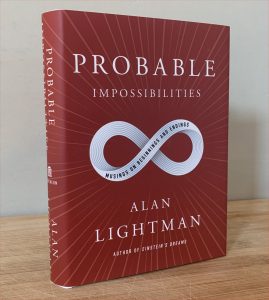 Alan Lightman: PROBABLE IMPOSSIBILITIES (2021)
Alan Lightman: PROBABLE IMPOSSIBILITIES (2021)
This is a new book of essays by a professor at MIT, author of earlier books including the well-regarded novel Einstein’s Dreams (Wikipedia, way back in 1993) and most recently of essay collection Searching for Stars on an Island in Maine, which I reviewed here in 2019. I was dubious then about Lightman’s straining for the kind of “meaning” that doesn’t actually exist in our vast, inhuman universe. Yet his insights are valuable; he is attuned to the patterns of the universe in a way few people are; and this book has some striking essays.
The book consists of 17 essays, plus notes. Some of these essays are chatty, as when the author interviews various specialists. I’ll just mention the highlights.
- Title essay: How tracing your ancestors back through time leads to the beginning of life on earth. How every atom in your body was made in stars, and how we know this. How we live between two endpoints of the infinity of the small and the infinity of the large.
- “Between Nothingness and Infinity.” About the value of imagination, which some scientists dismiss as non-science.
- “What Came Before the Big Bang?” Review of ideas by Einstein, Sean Carroll, Alan Guth. Perhaps time didn’t exist before the Big Bang. Alexander Vilenkin, Hawking, Krauss.
- “One Hundred Billion.” The coincidence: the number of neurons in our brain is about equal to the number of stars in a galaxy.
- “Smile”, page 86. The most striking essay of the lot. It describes, superficially, a man and woman leading their separate mornings, and then encountering each other at a lake, and smiling at each other – but deeply, a narrative told in terms of how many atoms, how many bits of light, how many such things occur so quickly, that led to that smile. In ordinary life we don’t appreciate the speed of chemical reactions that underlie every movement and thought that we have. (This struck me especially since reading Fantastic Voyage last week, the Asimov novel based on the 1966 film, which I happened to have just watched today, and which both film and novel I’ll explore in a review for Black Gate soon.)
- And similarly, “The Anatomy of Attention,” how our brains are bombarded with inputs every moment, and how brains process them..
- “Immortality”; author muses on death. That the atoms of his body will eventually become parts of other people, is a kind of immortality. [This echoes my own essay here, http://www.markrkelly.com/Blog/2020/11/08/the-afterlives-part-2/, about the survival of the atoms, i.e. our bodies, but not of our minds.)
- “In Defense of Disorder.” How we like asymmetry, predictability but also spontaneity. Sensibility to surprise and change. The “wanderlust” gene, that entails exploration and risk. Instead of thinking in terms of polar opposites, this in terms of useful balances, e.g. yin and yang. And author evokes the 3rd movement of Bruckner’s 9th.
- “Miracles.” About the apparent contradiction of believing in miracles while trusting science. Perhaps because in the modern world we’re increasingly distanced from nature. Yet that nature is lawful has been enormously useful and successful. All cultures have a concept of Mother Nature. Belief in the spiritual universe arises from the human desire from meaning. Yet physical principles reveal no evidence for miracles, or any other kind of reality.
- “Our Lonely Home in Nature.” Natural disasters: all evidence suggests nature doesn’t care anything about us. Nature is mindless.
- “Is Life Special?” How the Kepler observatory has found that about 10% of stars have habitable planets. Still, the fraction of living material in the universe is fantastically small.
- “Cosmic Biocentrism.” Freeman Dyson and the future of the universe: how in 1998 it was discovered the universe’s expansion is accelerating. How the Hindus projected long periods of time, and a cyclic universe. Lucretius had such thoughts. Life is a flash in the pan, considering the age of the universe.
- “The Man Who Knows Infinity.” Citing Borges. What if time and space are infinite; there would be infinite copies of each of us somewhere out there. Citing Andrei Linde at Stanford: There may be a vast number of universes, each spawning new universes. Ideas of the universe: how it was once thought to be fixed under a dome; then thought to be infinite but eternal and static; then realized to be expanding. How Hawking challenged Linde, and how Linde explained how he was right after all.





